Services on Demand
Journal
Article
Indicators
-
 Cited by SciELO
Cited by SciELO -
 Access statistics
Access statistics
Related links
-
 Similars in
SciELO
Similars in
SciELO  uBio
uBio
Share
Revista de Biología Tropical
On-line version ISSN 0034-7744Print version ISSN 0034-7744
Rev. biol. trop vol.46 n.3 San José Sep. 1998
Abstract
The genus Jikradia Nielson extends from eastern North America to Central America and the Galapagos Islands. Four additional new species are described and illustrated: J. mexicana (Mexico) J. longa (Costa Rica, Guatemala, Mexico), J. zurquiensis (Costa Rica) and J. lizanoi (Costa Rica). J. mexicana general color is ochraceous; the aedeagus without seta-like spine. Jikradialonga, general color is light ochraceous; the aedeagus with long seta-like process subapically with three spine-like setae opposite to single subapical seta. Jikradia zurquiensis, general color brown; aedeagus with single seta-like process subapically with three small spine-like setae basad of single subapical setae on the opposite lateral margin of aedeagus. Jikradia lizanoi, general color brown; aedeagus asymmetrical, long, narrow, tube-like, in lateral aspect with sharply pointed apex, with two long seta-like processes subapically with four spine-like setae. A revised key to all known species, and subspecies, based on male genitalia, is also presented.
Key words
Leafhopper, Cicadellidae, Coelidiinae, Jikradia, new species, key to species.
The Coelidiinae leafhoppers occur primarily in the tropics of the Southern Hemisphere. Only a few species occur in the Temperate Zone and these are all of tropical origin. Generic diversity is greatest in the Neotropical Region whereas species diversity is greatest in the Oriental realm (Nielson 1975). Little is known about the biology of the subfamily. Two species are reported to be virus vectors: Calodia kirkaldyi Nielson is the vector of sandalspike disease of sandalwood that is prevalent in southern India (Nielson 1982) and Jikradia olitoria olitoria (Say) is reported to be the vector of strawberry pallidosis (Nielson 1975) in the eastern United States.
Nielson (1979) described the genus Jikradia, in which he treated eight species and six subspecies. The range of this genus extends from eastern North America to Central America and the Galapagos Islands (Ecuador). Jikradia serrata Nielson occurs in Guatemala, Honduras, El Salvador and Panama; J. uniseta Nielson in Honduras, Guatemala
and Mexico; J. basipendula Nielson in Costa Rica and Mexico; J. bispinosa Nielson in Guatemala and Mexico; J. krameri Nielson in Honduras; J. cornicula Nielson in Guatemala and Mexico. The species J. melanota (Spångberg) consists of four subspecies: J. melanotamelanota (Spångberg) in the southeastern USA, Bahamas and Cuba; J. melanota galapagoensis (Osborn) in the Galapagos, Mexico and Central America; J. melanota bahamensis Nielson in the Bahamas; J. melanotacostaricensis Nielson in Panama, Costa Rica, El Salvador and Honduras. The species
J. olitoria (Say) consists of two subspecies: J. olitoriaolitoria (Say) in the USA and Canada; J. olitoria floridana (Lawson) in the southeastern USA. This paper describes four new species from Mesoamerica, one from Costa Rica, Guatemala and Mexico and three from Costa Rica, giving a total of twelve species and six subspecies now known in the genus. Illustrations of the species and subspecies described by Nielson (1979) are also presented.
Materials and Methods
The details of preparations of genital structures of leafhoppers for dissections and study are given by Oman (1949). We have followed his method with some modifications. A system was devised in which the abdomens of 20-30 leafhoppers were cleared simultaneously. Abdomens were removed, placed in ten percent potassium hydroxide and left to soak overnight at room temperature. The following day individual abdomens were washed in water before examination and eventual preservation in glycerin in microvials.
Specimens are deposited in the following collections:
BYU: Monte L. Bean Museum, Brigham Young University, Provo, USA.
CAS: California Academy of Sciences, San Francisco, USA
INBio: Instituto Nacional de Biodiversidad, Santo Domingo, Heredia, Costa Rica.
NHM: The Natural History Museum, London, UK
UCR: University of Costa Rica, San Pedro, San José, Costa Rica.
Type-species: Jassus olitoria Say
Medium-sized, slender leafhoppers. Color light fuscous to light piceous, sometimes ochraceous throughout.
Head narrower than pronotum, anterior margin broadly rounded; crown produced slightly beyond anterior margin of eyes, interocular width narrower than transocular width,slightly depressed, lateralmargins convergent basally; ocelli small, situated near anterior margin of crown; pronotum large, median length about equal to median length of crown; scutellum large, median length greater thanmedian length of pronotum; fore wing elongate,three anteapical cells present, outer one closed, five apical cells present;veins distinct; appendix well developed; clypeus elongate,narrow, with a prominent median longitudinal carina, lateral margins parallel, surface finely granulose; clypellus long, lateral margins prominently expanded apically. Male genitalia partially asymmetrical; pygofer large without caudodorsal or caudoventral processes; 10th segment long and narrow, without ventral processes; aedeagus asymmetrical, very long, slender, tube-like throughout, with or without subterminal processes; gonopore subapical; connective Y shaped with long arms, short stem; style long, very slender, needlelike, curved; dorsal apodeme sclerotized, slender and long; plate long and narrow, sligthly expanded at apical 1/2, setaceous at apical 1/2.
Diagnosis. Length: 6 mm. General color ochraceous; fore wing with flavous spots in extreme apex of 5a cell; vertex, genae, clypeus and clypellus mustard yellow; front coxae dark brown.
Pygofer in lateral aspect without caudodorsal or caudoventral processes (Fig.1); 10th segment long and narrow without ventral processes; aedeagus asymmetrical, long, narrow, tube-like, curved in lateral aspect, with sharply pointed apex without seta-like spine, gonopore subapical (Fig. 2); connective Y-shaped, arms long, stem short (Fig. 3); style long and narrow, curved in lateral and dorsal aspect (Figs. 4 A, 4 B); plate long and narrow with numerous spines along lateral margin in apical 1/2 (Fig. 5).
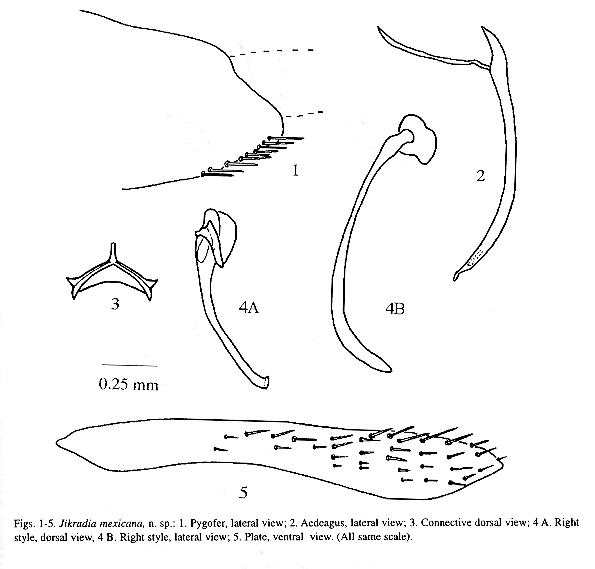
Material examined. Holotype (). MEXICO: Teapa, Tabasco, March, H.H.S., Brit. Mus. 1893-141. (NHM). Paratypes. 1
, MEXICO: Amula, Guerrero, 600 ft., Sept.., 1893, H. H. Smith (NHM); 1
, Orizaba, 78, P. R. Uhler collection (NHM).
Remarks. J. mexicana is similar in certain male genitalic characteristics to J.uniseta but can be distinguished from it by the lack of a long subapical seta of the aedeagus. The general color of J. mexicana is ochraceous and J. uniseta is piceous.
Diagnosis. Length: 7.3-7.5 mm. General color light ochraceous; fore wing veins brown; vertex, genae, clypeus and clypellus light ochraceous; legs yellow.
Pygofer in lateral aspect without caudodorsal or caudoventral processes (Fig. 6); 10th segment long and narrow; aedeagus asymmetrical, long, narrow, tube-like, broadly curved in lateral aspect with sharply pointed apex, in lateral aspect with long seta-like process subapically originating laterally in ventral aspect with three spine-like setae opposite to single subapical seta, gonopore subterminal (Figs.7 A, 7 B); connective Y-shaped, arms long, stem short (Fig. 8); style long and slender, broadly curved in lateral aspect, nearly as long as aedeagus (Fig. 9); plate long and narrow, constricted subbasally with numerous spines along lateral margin on apical 1/2 (Fig. 10).
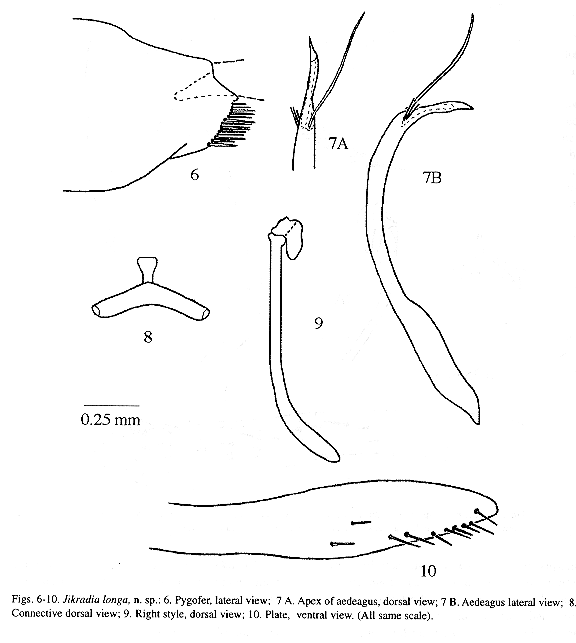
Unknown.
Material examined. Holotype (). COSTA RICA: Guanacaste Prov., Playa Naranjo, Santa Rosa P.N., M. Zumbado, Ene. 1991, L-N 309300-353300 (INBIO). Paratypes. 1
, COSTA RICA: Prov. Guanacaste, San Lucas, 7-7-34, No 2884, CH Ballou, on Spondias mombin (NHM); 1
, Est. Sta Rosa, 300 m. P. N. Sta Rosa, (INBio); 1
, III Curso Parataxonomos, Feb. 1992, L-N 313000, 359800 (CAS); 1 male same data (UCR); 1
same data (BYU); 1
, GUATEMALA: Baja Verapaz, Rabinal, VII 23-1964. J. E. Slansky collector (NHM); 1
, MEXICO: Tuxtla Gutiérrez, El Chorriadero, Chris IX 26-61, Javier Vásquez G. (NHM).
Remarks. J. longa is very similar in male genitalic characteristics to J. basipendula but can be distinguished from that species by the presence of three small spine-like setae basad of the gonopore. In size J. longa males are longer than J. basipendula.
Diagnosis. Length: 7 mm. General color brown; fore wing with white spots on costal margin; vertex brown or yellow, genae yellow, clypeus with median longitudinal carina with longitudinal yellow stripes, lateral margins brown, clypellus brown; legs yellow.
Pygofer in lateral aspect without caudodorsal or caudoventral processes (Fig. 11); 10th segment long and narrow; aedeagus asymmetrical, long, narrow, tube-like, broadly curved in lateral aspect with sharply pointed apex, with single seta-like process subapically originating laterally in dorsal aspect and with three small spine-like setae basad of single subapical setae on the opposite lateral margin of aedeagus in ventral aspect; gonopore subapical (Figs. 12 A, 12 B, 12 C); connective Y-shaped, arms long, stem short (Fig. 13); style long and slender, broadly curved in lateral aspect, nearly as long as aedeagus (Fig. 14); plate long and narrow with row of long stout setae on apical 1/2 (Fig. 15).
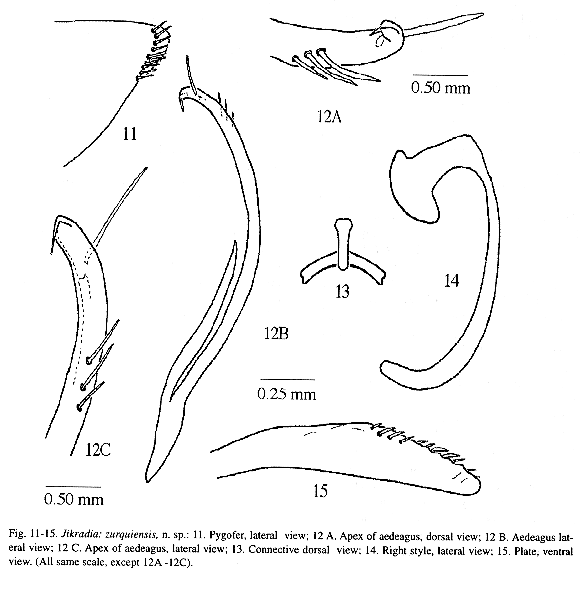
Unknown.
Material examined. Holotype (). COSTA RICA: San José. P. N. Braulio Carrillo, 9.5 Km. E. túnel, 1100 m, V-VI-1990, Godoy-Hanson (INBio). Paratypes. COSTA RICA: Prov. Guanacaste, 1
, Rio San Lorenzo, 1050m, Tierras Morenas, Z. P. Tenorio, Abril 1991, C. Alvarado, L-N 287800, 427600 (CAS); 1
, Prov. Limón, Est. Hitoy Cerere, Res. Biol. Hitoy Cerere, G. Carballo 4-20 Dic. 1991, L-N 184200-643300 (NHM); 1
, Prov. Puntarenas, Rancho Quemado, 200m, Península de Osa, Francisco Quesada, Mar. 1992, L-S 292500, 51100 (BYU). 1
, Rio San Lorenzo, 1050m,. Estación Sirena, 0-100m, P.N. Corcovado, Jun. 1991, J.C. Saborio, L-S 270500, 508300 (UCR); 1
, same locality, 21 mar. a 21 abr. 1992, Z. Fuentes, (INBio).
Remarks. J. zurquiensis is similar in male genitalic characteristics to J. melanota but can be distinguished from it by the longer spine-like setae and single seta-like process. The face in J. zurquiensis has longitudinal yellow stripes, a feature not observed in J. melanota
Diagnosis. Length: 6.5 mm. General color brown; fore wing with costal area yellow; vertex, genae, clypeus and clypellus yellow; legs brown.
Pygofer in lateral aspect without caudodorsal or caudoventral processes; 10th segment long and narrow (Fig. 16); aedeagus asymmetrical, long, narrow, tube-like, in lateral aspect with sharply pointed apex, with two long seta-like processes subapically originating laterally in ventral aspect with four spine-like setae, gonopore subterminal (Fig. 17 A, 17 B, 17 C); connective Y-shaped, arms long, stem short (Fig. 18); style long and slender, broadly curved in lateral aspect, nearly as long as aedeagus (Fig.19); plate long and slender, broadly curved in lateral aspect, nearly as long as aedeagus, long and narrow, constricted subbasally with numerous spines along lateral margin on apical 1/3 (Fig. 20).
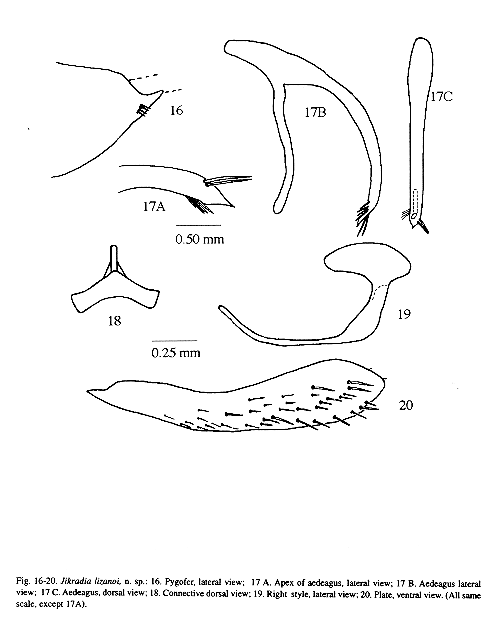
. Unknown.
Material examined. Holotype (). COSTA RICA, Heredia, Vara Blanca, Finca Georgina, 2100 m. V-VI-1990. Hanson. (INBio).
. COSTA RICA, San Ramón de Tres Rios, 10 Aug. 1972, Maldonado C. (NHM).
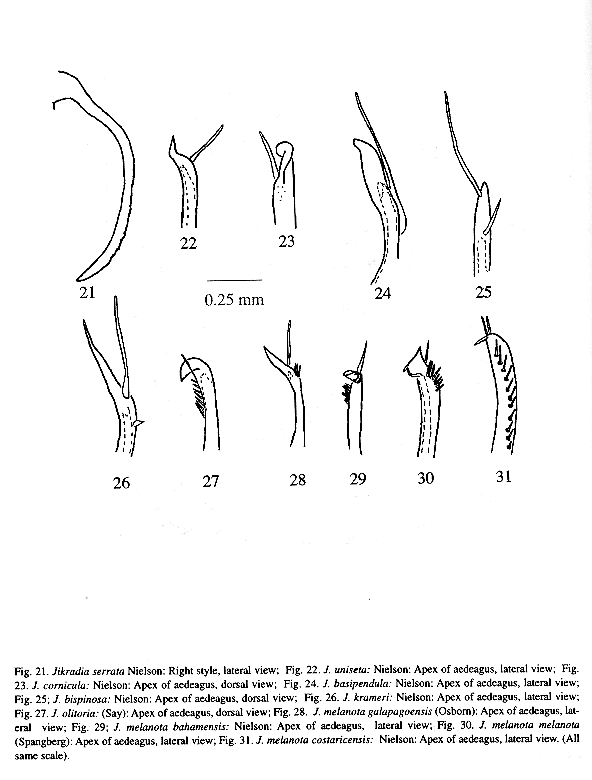
Remarks. J. lizanoi is similar in male genitalic characteristics to J. melanota but can be easily distinguished by the presence of two subapical aedeagal processes on the same side. We dedicate this species to Jorge Arturo Lizano for allowing us to collect on his property.
| 1. Aedeagus without setae on shaft | 2 |
| - Aedeagus with setae on or near apex of shaft | 3 |
| 2. Style with latero-apical margin serrate (Fig. 21) | . serrata Nielson |
| - Style with latero-apical margin smooth (Figs. 4) | mexicana, n. sp |
| 3. Aedeagus with only 1-2 setae apically | . 4 |
| - Aedeagus with numerous setae apically or subapically | 8 |
| 4. Aedeagus with 1 apical seta | 5 |
| - Aedeagus with 2 apical setae | . 7 |
| 5. Aedeagus with seta arising basad of gonopore | . 6 |
| - Aedeagus with seta arising distad or aligned with gonopore (Fig. 22) | .uniseta Nielson |
| 6. Aedeagus with very long seta arising considerably basad of gonopore, apex narrowed in ventral view (Fig. 24) | basipendula Nielson |
| - Aedeagus with moderately long seta arising basad of but near gonopore, several spicules near base of seta, apex broad in ventral view (Fig. 23) | cornicula Nielson |
| 7. Aedeagus with gonopore basad of apical setae (Fig. 25) | bispinosa Nielson |
| - Aedeagus with gonopore between apical setae (Fig. 26) | . krameri Nielson |
| 8. Aedeagus with 1-2 long apical setae and a row of short to long subapical setae | 9 |
| - Aedeagus without apical setae, but with a short to long row of subapical setae (Fig.27) | olitoria (Say) |
| 9. Clypeus with longitudinal yellow stripes | . zurquiensis, n. sp. |
| - Clypeus without longitudinal yellow stripes | . 10 |
| 10. Length of males between 4.7 and 6.7 mm, color ochraceous, fuscus to light testaceous | . 11 |
| - Length of males between 7.3 and 7.5, color yellow (Fig. 8) | . longa n. sp. |
| 11. Pygofer with 4 caudodorsal spines (Fig. 16) | . lizanoi, n. sp. |
| - Pygofer with 9 or more caudodorsal spines | melanota (Spångberg) |
| 1. Aedeagus with a single apical seta and a row of short setae basad of apical seta (Fig. 28) | 2 |
| - Aedeagus with 2 apical setae and row of short setae basad of apical setae (Fig. 31) | 3 |
| 2. Large, narrow species, length 5 mm or more; fore wings black with yellow or ivory costa (Fig. 28) | . m. galapagoensis (Osborn) |
| - Small, narrow species, length less than 5 mm; fore wing uniformly ochraceous (Fig. 29) | m. bahamensis Nielson |
| 3. Aedeagus with a short row of setae basad of apical setae (Fig. 30) | m. melanota (Spångberg) |
| - Aedeagus with a very long row of setae basad of apical setae (Fig. 31) | . m. costaricensis Nielson |
Acknowledgements
The authors thank the curators of the CAS, NHM, UCR. for loans of specimens andspecially Gabriel Mejdalani, Paul Freytag, William Ramirez and Paul Hanson for their valuable comments on the manuscript.
Resumen
Se describen e ilustran cuatro especies nuevas de Jikradia Nielson: J. mexicana (México) J. longa (Costa Rica, Guatemala, México), J. zurquiensis (Costa Rica) y J.lizanoi (Costa Rica). El trabajo inlcuye una clave ilustrada para todas las subespecies, con base en los aparatos genitales masculinos.
References
Nielson, M. W. 1975. A revision of the Subfamily Coelidiinae (Homoptera: Cicadellidae). Tribes Tinobregmini, Sandersellini and Tharrinii. Bull. Br. Mus. Nat. Hist. Entomol. Suppl. 24.7-8 [ Links ]
Nielson, M. W. 1979. A revision of the Subfamily Coelidiinae (Homoptera: Cicadellidae) III. Tribe Teruliini. Pac.Ins. Monograph 35: 75-95. [ Links ]
Nielson, M. W. 1982. A revision of the Subfamily Coelidiinae (Homoptera: Cicadellidae) IV. Tribe Coelidiini. Pac.Ins. Monograph 38: 169-170. [ Links ]
Nielson, M. W. 1989. Additional new species of Teruliine leafhoppers with key to species (Cicadellidae: Coelidiinae: Teruliini). Great Basin Nat. 49: 398-403. [ Links ]
Oman, P. W. 1949. The Nearctic leafhoppers (Homoptera: Cicadellidae). A generic classification and check list. Mem. Ent. Soc. Wash. three: 1-253 [ Links ]
1Instituto Nacional de Biodiversidad, Apartado Postal 22-3100 Santo Domingo, Heredia, Costa Rica.
2 Monte L. Bean Museum, Brigham Young University, Provo, UT 84602 USA.














